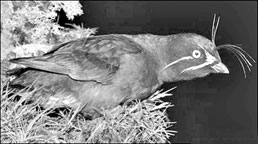|
Auklets and penguins:
Birds use feathers 'to touch'
by Matt WALKER
|

A whiskered auklet feels in the dark
|
Birds may use their feathers for touch, using them to feel their
surroundings just as cats use their whiskers.
The revelation that feathers have this hitherto unknown function
comes from research on auklets, birds that sport prominent plumes on
their heads.
Auklets with bigger crests, that stick out further, bump into things
less.
A wider analysis suggests that numerous birds, from parrots,
penguins, pheasants and hummingbirds, also use their feathers to feel
their way.
Details of the discovery are published in the journal Animal
Behaviour.
Many species of bird sport elegant long feathers, either crests,
beards or whiskers that adorn the head and face, or striking tail
feathers.
Many of these feathers are thought to have a sexual function, being
used to advertise a bird's virility to potential mates.
But Dr. Sampath Seneviratne of the University of British Columbia in
Vancouver, Canada and Professor Ian Jones of Memorial University in St.
John's, Canada suspect they may also have a tactile function.
Bumping heads They explored why a group of birds called auklets have
evolved such elaborate head feathers.
Within the genus Aethia, a number of species have different shaped
feathers, but both males and females tend to look the same. The birds
usually breed in dark, rocky crevices.
The researchers placed individual auklets into a dark experimental
maze, designed to resemble a natural crevice, and recorded how often
they bumped into things.
Both crested and whiskered auklets bumped their heads 2.5 times more
often if their feathers on their heads had been artificially flattened.
Also, "without the aid of the crest, naturally long-crested
individuals had more head bumps than short-crested individuals," Dr
Seneviratne told the BBC.
The two ornithologists then conducted a wider comparative analysis:
checking which bird species sport long ornamental feathers against their
lifestyles and where such birds live.
What emerged was a striking pattern.
"Birds that live in complex, cluttered habitats and are active at
night tend to have a greater probability to express such facial
feathers," says Dr Seneviratne.
"We found a highly significant correlation for the observed trend."
Penguins to parrots The pattern held true across all non-passerine
birds, which comprise about half of all bird species. The researchers
did not include passerine, or perching birds, in their analysis.
That means that various species of penguin, parrot, cormorant, owl,
hummingbird, kingfisher, woodpecker and game birds such as partridge and
pheasant, may all use certain feathers for touch.
Such species have facial feathers variously called crests, beards,
whiskers, rictal bristles and orbital plumes.
Dr. Seneviratne and Prof Jones suspect that similar feathers, such as
the long streamers found on birds of paradise or the pin and forked
tails of other species, and even protruding feathers on some birds'
wings, may fulfil a similar function.
Biologists have long wondered and debated why birds have long
ornamental feathers.
Many do so for camouflage, as a warning to startle predators, or to
advertise their prowess.
For example, "long facial feathers are generally thought to be 'sexy
ornaments' used to seduce choosers and for assessment of the presenter,"
says Dr Seneviratne.
Cat's whiskers but while such feathers may have acquired these
functions, their original purpose may have been to provide a similar
function as a cats' whiskers or a blind person's cane.
By providing sensory feedback to a bird about its environment, such
feathers can provide a distinct advantage, particularly to birds living
in dark or crowded environments.
"Birds living in complex habitats are likely to encounter greater
density of objects or clutter that they have to avoid." So such feathers
could help birds avoid bumping into burrow ceilings, tree branches and
undergrowth.
Feathers around the face would prove especially useful, as they might
stop a bird damaging vital organs, such as eyes, eardrums, nostrils and
bill.
"We describe the first comparative evidence for this widespread but
entirely overlooked sensory function of long facial feathers.
"We argue that this provides a hitherto missing explanation for the
origin of ornamental feathers," says Dr. Seneviratne.
- BBC
|

